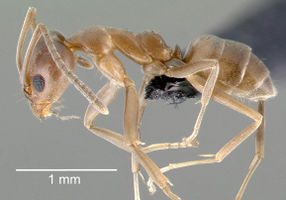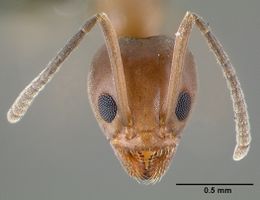Difference between revisions of "Linepithema humile"
| Line 1: | Line 1: | ||
| − | {{TaxLinks| | + | {{TaxLinks|LnkLinepithema}} |
{{LiteratureDB|{{PAGENAME}}|browse,benefialsN}} | {{LiteratureDB|{{PAGENAME}}|browse,benefialsN}} | ||
[[File:Linepithema Argentine ant.jpg|250px|thumb|''Linepithema humilis'', Argentine ant<br/>Source: [http://commons.wikimedia.org/wiki/File:Linepithema_Argentine_ant.jpg Wikimedia Commons]]] | [[File:Linepithema Argentine ant.jpg|250px|thumb|''Linepithema humilis'', Argentine ant<br/>Source: [http://commons.wikimedia.org/wiki/File:Linepithema_Argentine_ant.jpg Wikimedia Commons]]] | ||
| Line 24: | Line 24: | ||
</gallery> | </gallery> | ||
| − | [[Category: | + | [[Category:Linepithema (genus)]] |
Revision as of 16:41, 26 September 2016
| Literature database |
|---|
| 268 articles sorted by: |
| • year (recent ones first) |
| • research topics |
| • countries/regions |
| • list of natural enemies |
Linepithema humile (Mayr, 1868) - (Argentine ant)
The ant is native to northern Argentina and southern Paraguay. It has invaded many other regions with a Mediterranean-type climate and now has an almost world-wide distribution. The ant has become a serious urban pest in the invaded areas. It readily enters houses in search for food and water. In some regions, most of the requests for pest control services in houses are initiated after infestations by the Argentine ant.
Part of the success of the ant has been attributed to the fact that individuals from different nests rarely compete with each other and even exchange individuals and resources (polydomy). Therefore, the nests can be regarded as being part of "super colonies" which can extend over hundreds and thousands of kilometers. L. humile also tends aphids, scales and mealybugs and protects pests in agricultural areas. In addition, it suppresses native ants.
| Vernacular names | |
|---|---|
| • Deutsch: | argentinische Ameise |
| • English: | Argentine ant |
| • Español: | hormigas argentinas |
| • Français: | fourmi d'Argentine |
On the other hand it has also been also reported as a useful predator of pest insects. Toxic baits (e.g. sugar and boric acid) are often used as a control method, but this fails to kill the queens.
The ants build nests in the ground and typically form unicolonial colonies containing many queens. During the winter, the colonies contract in size, so called "winter nests". Female workers are about 2½ mm long, males about 3 mm. The development time from egg to adult worker is about 3 months.
For more details see the respective page in Wikipedia.
- Other images of Linepithema humile (Wikimedia Commons - click to enlarge)


